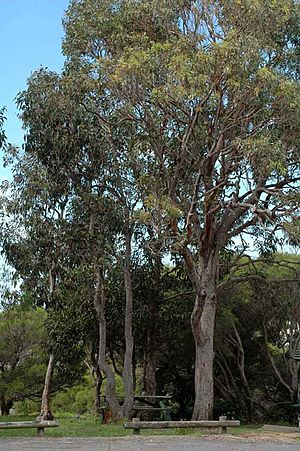Woollybutt facts for kids
Quick facts for kids Woollybutt |
|
|---|---|
 |
|
| Eucalyptus longifolia near Eden | |
| Scientific classification | |
| Genus: |
Eucalyptus
|
| Species: |
longifolia
|
| Synonyms | |
|
|
The Woollybutt (Eucalyptus longifolia) is a special type of tree. It is found only in eastern Australia. This means it is endemic to that area. It is a medium-sized tree with thick, rough bark. Its leaves are long and curved. The flowers are white and grow in groups of three. After flowering, it produces cup-shaped fruits. These drooping flower groups are a key way to tell it apart from other trees. Woollybutt trees often grow in heavy soils, especially near water.
Contents
What Does the Woollybutt Look Like?
The Woollybutt tree can grow very tall, up to about 35 meters (115 feet) high. It has rough bark that feels like fibers or flakes. This bark covers its trunk and larger branches. The trunk can be as wide as 1 meter (3 feet).
Leaves and Flowers
Young Woollybutt plants have leaves that are shaped like an egg. These leaves are about 6.5 to 20 cm (2.5 to 8 inches) long. Older trees have long, curved leaves. They are a dull grayish-green color on both sides. These adult leaves are about 9 to 25 cm (3.5 to 10 inches) long. They grow on a stalk called a petiole.
The tree's flower buds hang down in groups of three. Each group grows on a stalk called a peduncle. The buds are oval or diamond-shaped. They are about 1.6 to 2.7 cm (0.6 to 1 inch) long. Woollybutt trees bloom from March to June. Their flowers are white.
Fruit and Seeds
After the flowers, the tree produces woody fruits. These fruits are like capsules. They are shaped like a cup, cylinder, or half-sphere. They are about 0.8 to 1.5 cm (0.3 to 0.6 inches) long.
How the Woollybutt Got Its Name
The Woollybutt tree was first officially described in 1822. This was done by a scientist named Johann Heinrich Friedrich Link. He wrote about it in his book. The name longifolia comes from two Latin words. Longus means "long," and folium means "leaf." So, longifolia means "long-leaved."
Where the Woollybutt Lives
The Woollybutt tree grows in central and southern New South Wales, Australia. You can find it from Morisett in the north down to the border with Victoria. It is more common in the southern parts of its range.
Preferred Habitat
These trees usually grow in clay soils. They are often found in floodplains or low areas. Sometimes, they even grow where the ground does not drain well.
Tree Neighbors
In open forests, Woollybutt trees grow alongside other native trees. These include white mahogany, grey box, and forest red gum. In swampy areas, they might grow with swamp mahogany and different types of paperbark trees.
How the Woollybutt Survives and Thrives
The Woollybutt tree is very tough. If a bushfire damages its top branches, it can grow back. It does this using special buds hidden under its bark. These are called epicormic buds. Woollybutt trees can live for more than a hundred years!
Animals and the Woollybutt
Many animals enjoy the Woollybutt tree. Birds visit its flowers for nectar. Two types of flying foxes, the grey-headed flying fox and the little red flying fox, also feed on the sweet nectar from its flowers.
Uses of the Woollybutt Tree
The wood from the Woollybutt tree is dark red. It is very hard and strong. It also resists water and termites. Because of these qualities, it has been used to make railway sleepers. It is also used in other types of building.
Other Benefits
Woollybutt trees are also important for beekeeping. Bees collect nectar from their flowers to make honey. Farmers sometimes use Woollybutt trees in their fields. They provide good shade for animals and help block strong winds. However, they grow too big for most home gardens.
Images for kids



